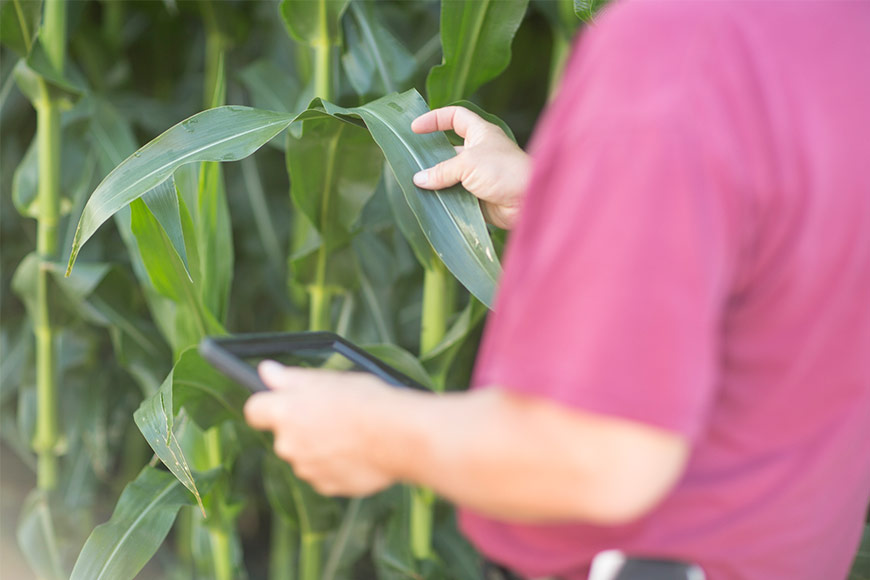Power Up Your Tech Now for Scouting

The weather is getting warmer and the days are getting longer. That means planting season is upon us — at least in my area of southeastern Minnesota. But you might be wondering why I’m talking about scouting now, when it’s barely May. The reason is, planning your scouting strategy today will help save you precious time later in the growing season.
If you haven’t already done so, meet with your agronomist to determine what technology you can use to aid your scouting efforts this year. There are a number of tech tools that work smoothly with boots-on-the ground scouting to give you a complete picture of field health — from eye level and from sky level. Here are a few things to consider when thinking about the best ways to scout this summer.
1. Use in-season imagery to help identify areas of difference.
In-season satellite imagery shows your fields divided into zones and indicates whether those zones have low, medium or high levels of biomass — a measure of plant density and health. Identifying differences in field biomass lets you know exactly where to scout. A field with low biomass may just be a poor-performing field. But a traditionally high-performing field with low biomass could indicate insect or disease pressure.
2. Focus scouting efforts to save time.
Determine current field pressures and where they are occurring, and identify potential problems. The recently updated Scout Pro app enables easy identification of any weed, insect or disease issues using university reference information. It can also capture photos and then georeference them to the spot in the field where they were taken. Scout Pro can create efficiencies in communication between you and your agronomist with an easy-to-use reporting function.
3. Target input applications to advance sustainability, save money.
Ag technology can help you place inputs where and when they are most needed. And you have the ability to make targeted, timely, in-season adjustments that can add to your profitability potential. With technology, odds are you’re gaining more output per input.
For example, if you have to make a nitrogen application, technology found in the R7® Tool enables you to create a variable-rate nitrogen map based on scouting, and likely on results of tissue and soil sampling you also may have done. Of course, tissue and soil samples may also indicate a number of other macronutrient and micronutrient deficiencies.
It’s tough to farm in a vacuum. The growing use of ag tech will promote collaboration — particularly between farmers and agronomists, and even between farmers. Be sure to have your scouting strategy in place soon to get a leg up on the 2017 season.
If you haven’t already done so, meet with your agronomist to determine what technology you can use to aid your scouting efforts this year. There are a number of tech tools that work smoothly with boots-on-the ground scouting to give you a complete picture of field health — from eye level and from sky level. Here are a few things to consider when thinking about the best ways to scout this summer.
1. Use in-season imagery to help identify areas of difference.
In-season satellite imagery shows your fields divided into zones and indicates whether those zones have low, medium or high levels of biomass — a measure of plant density and health. Identifying differences in field biomass lets you know exactly where to scout. A field with low biomass may just be a poor-performing field. But a traditionally high-performing field with low biomass could indicate insect or disease pressure.
2. Focus scouting efforts to save time.
Determine current field pressures and where they are occurring, and identify potential problems. The recently updated Scout Pro app enables easy identification of any weed, insect or disease issues using university reference information. It can also capture photos and then georeference them to the spot in the field where they were taken. Scout Pro can create efficiencies in communication between you and your agronomist with an easy-to-use reporting function.
3. Target input applications to advance sustainability, save money.
Ag technology can help you place inputs where and when they are most needed. And you have the ability to make targeted, timely, in-season adjustments that can add to your profitability potential. With technology, odds are you’re gaining more output per input.
For example, if you have to make a nitrogen application, technology found in the R7® Tool enables you to create a variable-rate nitrogen map based on scouting, and likely on results of tissue and soil sampling you also may have done. Of course, tissue and soil samples may also indicate a number of other macronutrient and micronutrient deficiencies.
It’s tough to farm in a vacuum. The growing use of ag tech will promote collaboration — particularly between farmers and agronomists, and even between farmers. Be sure to have your scouting strategy in place soon to get a leg up on the 2017 season.


